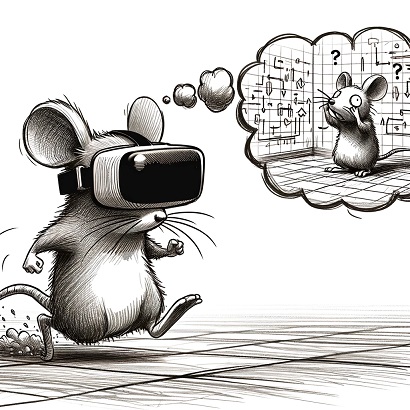Breakthrough Discovery: Walls, Not Floors, Define Spatial Navigation
The study, led by Dr Guifen Chen from Queen Mary University of London, delves into the brains of mice navigating a two-dimensional virtual reality (VR) environment, revealing the surprising importance of specific visual cues for building and maintaining spatial maps. It reveals that specific visual cues – in this case, elevated walls – are crucial for stabilising the neurons responsible for spatial navigation in virtual reality (VR).
“Our findings provide a significant step forward in understanding the precise nature of the sensory information that animals used for boundary detection,” says Dr Chen. “They not only highlight the importance of elevated boundaries in building spatial maps, but also reveal the brain’s remarkable ability to infer boundaries from sensorimotor mismatch even when they’re not directly visible.”
The research team conducted a fascinating experiment using virtual reality techniques. Mice navigated in a two-dimensional virtual environment, while the neural activity was monitored. Specifically, the study focuses on the activity of neurons crucial for navigation: place cells, which fire when the animal is in a specific location, and grid cells, which form a hexagonal grid-like map of the environment. This VR environment was a two-dimensional world that could be manipulated to include or exclude various visual elements. By monitoring the activity of these neurons, the scientists could observe how the mice’s spatial maps were updated in response to the manipulation within the VR world.
The most striking finding centered around the role of visual boundaries. When the VR environment included elevated walls, the place cells and grid cells in the mice’s brains fired consistently, indicating stable spatial maps. However, removing these walls caused the firing patterns of these cells to become erratic, demonstrating a disruption in the animals’ ability to navigate. Interestingly, removing cues from the floor of the VR environment had no significant impact. This suggests that the specific form of visual cues plays a crucial role in how animals build and maintain their internal maps.
Dr Chen worked with Xiuting Yang, a PhD student in her lab at the School of Biological and Behavioural Sciences at Queen Mary University of London, as well as Professor Francesca Cacucci, Professor Neil Burgess and Dr Tom Wills at UCL on this paper.
The research team believes these findings have broader implications for understanding real-world navigation. “Our results suggest that the elevated, not flat, boundary plays a crucial role in how animals maintain spatial maps,” explains Dr Chen. “This may explain why, for instance, young children struggle to use flat outlines of shapes for spatial orientation.”
This study opens doors for further research into the intricate interplay between sensory information, spatial memory, and navigation. It could pave the way for advancements in fields ranging from robotics and virtual reality development to a deeper understanding of spatial navigation disorders.

